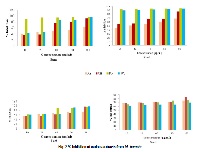Antioxidant Activity and Total Phenolic Content of Various Extracts from Mimosa hamata Willd., Mimosaceae
Keywords:
Mimosa hamata Willd, total phenolic content, antioxidant activity, folin-Ciocalteu’s reagent, 2,2-diphenyl-1-picryhydrazyl (DPPH), ascorbic acidAbstract
Jinjani (Mimosa hamata Willd., Mimosaceae) is widely distributed in India and Pakistan, which contains several interesting bioactive constituents and possesses health promoting properties. In this study, the antioxidant activity with the total phenolic content of different successive extracts (pet. ether, chloroform, n-butanol and water) from leaves, stem, root and seeds of M. hamata were assessed in an effort to compare and validate the antioxidant potential of the particular part of the plant. The antioxidant activity was determined by 2, 2- Diphenyl-1-picrylhydrazyl (DPPH) assay and total phenolic content was estimated by using Folin-Ciocalteu’s reagent. All tested extracts possessed appreciable antioxidant potential but n-butanol extract of roots was significantly higher in total phenolic content (73.16±0.19 mg GAE/g extract) and in antioxidant assay (IC50 = 5µg/ml). It is also noteworthy that in nbutanol extract of roots higher yield (85.60%) was also observed. This study validates the antioxidant potential of the roots in M. hamata and the positive relationship between total phenolic content and antioxidant activity.
References
. Hussain N, Modan MH, Shabbir SG,
Zaidi SAH. Antimicrobial principles
in Mimosa hamata. J. Nat. Prod.
;42:525-527.
. Patel NK. Ethnomedicinal plants used
for impotence, frigidity and sexual
weakness in Danta Taluka (Gujarat).
Life Sci. Leaf. 2010;1:14-21.
. Nadkarni AK, Nadkarni KM. Indian
Materia Medica. Popular Book
Depot, Bombay 1954.
. Chopra RN, Nayar SL, Chopra IC.
Glossary of Indian Medicinal Plants.
CSIR, New Delhi 1956.
. Mehta BK, Sharma S, Dubey A. 4-
Ethylgallic acid from two Mimosa
species. Phytochem 1998;27:3004-
. Jain R, Arora R. 3-O-L-Arabinosyl-Dglucosyl morolic acid from Mimosa
hamata. J. Med. Arom. Plant Sci.
;19:22-23.
Jain R, Arora R, Jain SC. Saponins
from the roots of Mimosa hamata
Willd. Indian J. Chem.
b;36B:61-64.
. Mukadam DS, Balkhande LD,
Umalkar GV. Antifungal activities in
deproteinized leaf extract of weeds
and nonweeds. Indian J. Microbiol.
;16:78-79.
. Umalkar GV, Mukadam DS,
Mehemiah AKM. Sci. Cult.
;43:437.
. Jain R, Arora R, Alam S, Jain SC.
Pharmacological evaluation of
Mimosa hamata roots. Fitoterapia
a;68:377-378.
. Jain SC, Jain R, Vlietinck AJ. In vivo
and in vitro antimicrobial efficacy of
Mimosa hamata. Indian J. Biotech.
;3:271-273.
. Jain SC, Jain R, Singh R.
Antioxidant activity of mimonosides
isolated from in vitro regenerated
plants of Mimosa hamata Willd.
Indian J. Plant Physiol.
;14:124-129.
. Singh R, Jain SC, Jain R.
Antioxidant activity of some
medicinally important arid zone
plants. Asian J. Exp. Sci.
;23(1):215-221.
. Scalbert A, Williamson G. Dietary
intake and bioavailability of
polyphenols. J. Nutr.
;130:2073S-2085S.
. Hertog MGL, Kromhout D, Aravanis
C, et al. Flavonoid intake and longterm risk of coronary heart disease
and cancer in Seven Countries
Study. Arch. Intern. Med. 1995;
:381-386.
. Keli SO, Hertog MGL, Feskens
EJM, Kromhout D. Dietary
flavonoids, antioxidant vitamins, and
incidence of stroke: the Zutphen
study. Arch. Intern. Med. 1996; 154:
-642.
. Steinetz KA, Potter JD. Vegetables,
fruit, and cancer prevention: a
review. J. Am. Diet. Assoc.
;96:1027-2039.
. Andriantsitohaina R. Regulation of
vascular tone by plant polyphenols:
role of nitric oxide. Gen. Physiol.
Biophys. 1999;18(1):3-5.
. Facino RM, Carini M, Aldini G, Berti
F, Rossoni G, Bombardelli E,
Morazzoni P. Diet enriched with
procyanidines enhances antioxidant
activity and reduces myocardial
post-ischemic damage in rats. Life
Sci. 1999;64:627-642.
. Leikert JF, Rathel TR, Wohlfart P,
Cheynier V, Vollmar AM, Dirsch VD.
Red wine polyphenols enhance
endothelial nitric oxide synthase
expression and subsequent nitric
oxide release from endothelial cells.
Circulation 2002;106:1614-1617.
. Rice-Evans CA, Miller NJ, Paganga
G. Structure antioxidant activity
relationship of flavonoids and
phenolic acids. Free Radical Biol.
Med. 1996;20:933-956.
. Davalos A, Bartolome B, GomezCordoves C. Antioxidant properties
of commercial grape juices and
vinegars. Food Chem. 2005;93:325-
. Zhang S, Bi H, Liu C. Extraction of
bioactive components from Rhodiola
sachalinensis under ultrahigh
hydrostatic pressure. Sep. Purif.
Technol. 2007;57:275-280.
. Fogliano V, Verde V, Randazzo G,
Retieni X. A method for measuring
antioxidant activity and its
application to monitoring the
antioxidant capacity of wines. J.
Agric. Food Chem. 1999;47:1035-
. Lee SK, Mbwambo ZH, Chung HS,
Luyengi L, Games EJC, Mehta RG,
Kinghorn AD, Pezzuto M. Evaluation
of the antioxidant potential of natural
products. Comb. Chem. High T. Scr.
;1(1):35-46.
. Bray HG, Thorpe WV. Analysis of
phenolic compounds of interest in
metabolism. Meth. Biochem. Anal.
;1:27-52.
. Ghasemzadeh A, Jaafar HZE,
Rahmat A. Antioxidant activities,
total phenolics and flavonoids
contents in two varieties of Malaysia
young ginger (Zingiber officinale
Roscoe). Molecules 2010;15:4324-
. Yingming P, Ping L, Hengshan W,
Min L. Antioxidant activities of
several Chinese medicinal herbs.
Food Chem. 2004;88:347-350.
. Louli V, Ragoussis N, Magoulas K.
Recovery of phenolic antioxidants
from wine industry by-products.
Bioresour. Technol. 2004;92:201-
. Evans WC. Pharmacognosy.
Harcourt Pub. Ltd., United Kingdom
. Keevil JG, Osman HE, Reed JD,
Folts JD. Grapes juice but not
orange juice or grapefruit juice,
inhibits human platelet aggregation.
J Nutr. 2000;130:53-56.
. Ribereau-gayon P. Plant Phenolics.
Oliver and Boyd, Edinburgh 1972..



